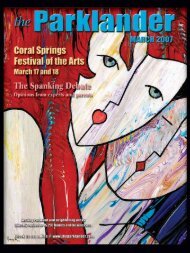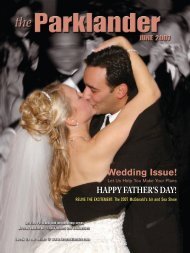September 2008 - The Parklander Magazine
September 2008 - The Parklander Magazine
September 2008 - The Parklander Magazine
Create successful ePaper yourself
Turn your PDF publications into a flip-book with our unique Google optimized e-Paper software.
RESTAURANT REVIEW<br />
By Charles Marcanetti<br />
French restaurants, it is said, are notable for their sauces. It stems from<br />
a time when all of Europe was dramatically poor and food was scarce.<br />
Meat was an especially rare luxury which only the very rich could<br />
afford. Places like England seem to have developed a penchant for<br />
stews which allowed for the inclusion of whatever was available.<br />
Scotland and Wales developed the fine art of utilizing organ foods so<br />
none of the slaughtered animal was wasted. Spain created fish stews<br />
and casserole-like dishes, again to use all of what was available. France<br />
developed the fine art of taking little used food items or commonly<br />
used but barely available items, use them sparingly and flavor them<br />
with creative and rich sauces. Each country thus allowed families to<br />
have the feeling of a satisfying meal when all too frequently the meals<br />
themselves were quite small and contained not too many desirable<br />
ingredients.Time passed and the economies improved enough to allow<br />
for better ingredients, but the creative period left some wonderful<br />
recipes. Necessity is surely the mother of invention and today we are<br />
privileged to have some incredible dishes that have been perfected from<br />
the countless years of trial and error.<br />
My recent visit to Le French Bistro located in the Parkland Town<br />
Center at 6676 Parkside Drive in Parkland (561-755-0708 -<br />
www.lefrenchbistro.com) brought me back many years to my autumns in<br />
Paris and my summers in a quaint little city called Les Sables D’Olonne.<br />
One might assume that, having spent so many years in France, I am an<br />
expert in French cooking. But it is untrue. I am, however, an expert in<br />
French eating. I mean it. <strong>The</strong> French do not eat as ravenously as we do.<br />
<strong>The</strong>y eat far smaller portions (again, a carry-over from a time when food<br />
was scarce) and they “dine” much more frequently (meaning they don’t<br />
rush their meals). Also, unpreserved bread and light wines are served with<br />
virtually all meals (well, maybe not for breakfast). So, because of the fresher<br />
bread, smaller portions, less rushed atmosphere and light wines, the French<br />
are generally thinner then we are, even in the face of their rich sauces.<br />
Well, if the French ate at Le French Bistro the “thinner” part might<br />
disappear. Because, like me, they’d eat and eat and eat, especially the preentrees<br />
(soups and appetizers) and the post entrees (desserts), which also<br />
became a specialty because of the lack of main course foods.<br />
<strong>The</strong> atmosphere at Le French Bistro is that of a small French restaurant,<br />
so common throughout the country, but more apparent in the small cities<br />
and country towns.<strong>The</strong> tables are small enough to be intimate but clearly<br />
large enough to avoid a crowded feeling. <strong>The</strong> linen tablecloths and<br />
napkins were crisp and soft hued. <strong>The</strong> silverware was gleaming-clean;<br />
sitting perfectly placed on tables nestled in among French bric-a-brac and<br />
all was permeated by authentic French music. <strong>The</strong> food could have been<br />
lousy and still the evening would have been great. But, the food was far<br />
from lousy. It was fresh and correctly prepared, sized and appointed. It was<br />
served by Joel (pronounced with two clearly distinguishable syllables, like<br />
the planet Krypton names [Jor-el, Kal-el, etc.]).<br />
At the outset, a very smoothly pureed Tapenade was served, and this<br />
blend of eggplant, olive oil and garlic and spices turned out to be a fine<br />
introduction to the remainder of the evening.<br />
We started with a 2006 Beaujolais by Henry Fessy. Like the food, it was<br />
light and crisp, with a soft bouquet and no aftertaste.<br />
When you go, and I think you ought to, you absolutely must have either<br />
the best Traditional French Onion Soup ($8.95) I’ve ever had, served in<br />
the onion, or a truly delicious Lobster Bisque Le Bistro Style ($8.50),<br />
served under puffed-pastry. Each was marvelous and a perfect<br />
introduction to our first appetizer, Escargots a la Persillade ($8.95). <strong>The</strong><br />
snails in this dish, as in all similar dishes, are actually a garlic delivery<br />
system, adding to the garlic a soft and smooth way to travel down our<br />
throats to our waiting stomachs. At Le French Bistro they have<br />
discovered a way to keep the garlic from overpowering you while<br />
maintaining the fullness of the dish.<br />
We next sampled the Norwegian Smoked Salmon (alone $10.95), but<br />
we added “a la Imperial Caviar” (total $17.50). It is served with chopped<br />
salad and garnished with diced onions, capers, egg whites and tartar<br />
sauce. <strong>The</strong> caviar was not as salty as I usually experience and with the<br />
Smoked Salmon ended up balancing very well.<br />
Our main courses started with the Rack of Lamb “Chef Style” Dijonaise<br />
($38.95) which is breaded and laced with mustard and tarragon, then<br />
84 SEPTEMBER <strong>2008</strong>
















